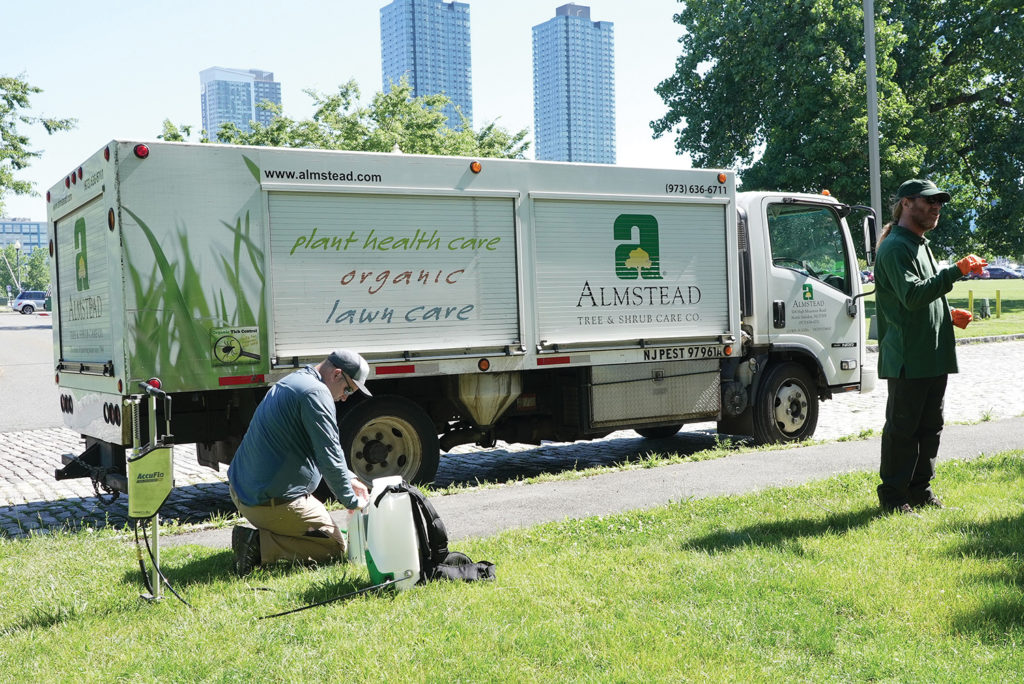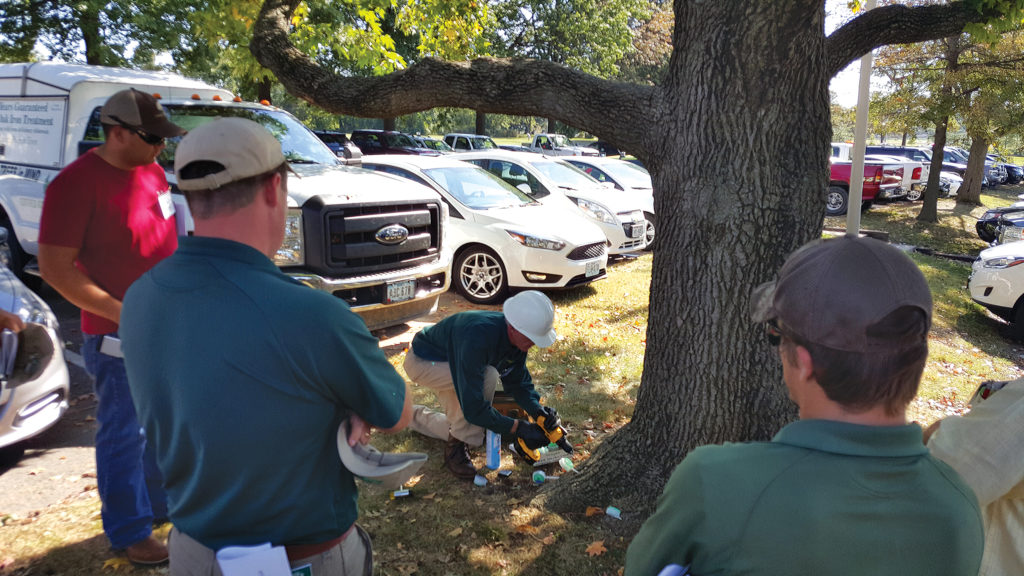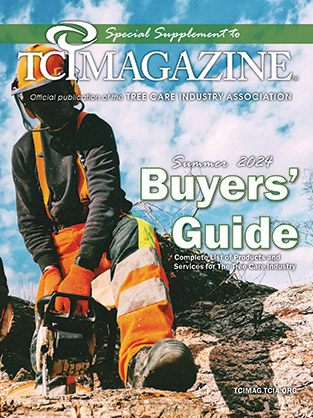Business of PHC, Part 4: Who Do You Need on Board to Get Started?

For the fourth installment of this series, we asked a number of industry professionals what we thought was a pretty simple question regarding staffing, training and credentials: “Who is the first person an owner needs to hire, and/or what is the first credential or skill a new or veteran employee needs to have or attain to get started?”
Here are the responses.
Joseph Eves, CTSP, owner, Coastal Tree Care, an accredited, five-year TCIA member company based in San Diego, California
Great question! I think there are a few options when making your first PHC hire. You can hire someone with extensive PHC experience who can bring a lot of value to your organization, but that may cost more in salary, and in the beginning you may not have the volume of PHC business to support that. Another option is to hire someone at an entry level and train them. This person should align with your core values and be passionate about the position. Lastly, and this is what we did, is to utilize someone already on your team.
When first starting out, you may only have a few PHC jobs a week, and it’s very difficult to create a full-time position around that. The salesperson and I would share PHC jobs until it became too much for us to manage. Then we trained one of our ground techs, and that person wore both of those hats for about a year while we continued to grow our PHC department.
We are in California, so the licensing requirements most likely differ from other states. We are required to first obtain our Qualified Applicator License (QAL) through the state and then we are required to be licensed through both the city and county.
Phillip Perron, PHC director, Barrett Tree Service East, Inc., an accredited, 14-year TCIA member company based in Medford, Massachusetts
The first person the owner needs to hire or promote from within is a PHC director. I think the owner can take this on at first, providing he/she has someone in mind to fill this role in the long term. I really think an owner can get stretched too thin if they are trying to run the tree side of things and PHC. Throw turf into that and it can get very messy. PHC, and certainly IPM (integrated pest management), is all about timing; if the owner is juggling too many different sides of the business, they run the risk of missing application windows.
A pesticide license is the first thing an employee will need. That is the starting point. Having good tree-and-shrub ID skills is a must as well. The other skills can be taught, but if you can’t ID what you are sent to treat, not much else matters.
Zack Shier, PHC manager, Joseph Tree Service, an accredited, nine-year TCIA member company based in Dublin, Ohio
To start, all you really need is an employee to run the PHC truck. If you’re a tree service getting into PHC, your regular office staff can help with scheduling and customer service. If you’re doing pest or disease treatments, you will need someone to decide when to do certain treatments. This could be the sales arborist or the person running the PHC truck. As the PHC section grows, the person running the PHC truck may take over all PHC-related roles, such as scheduling timed treatments, ordering of chemicals and PPE and applying treatments.
As your PHC section grows even more, you’ll most likely need a PHC manager and separate PHC technician(s). The unique part of PHC, when it comes to staffing, is training your schedulers or having someone trained to communicate with your schedulers when certain treatments need to be done. The fact that pests come out according to growing degree days (GDD), not exact dates, and that fungal diseases infect trees during specific weather events and not according to GDD, can make scheduling a bit of a nightmare sometimes. The communication between whoever is monitoring when to start certain treatments and the person scheduling the jobs needs to be heightened.

The number-one most important credential to have for a PHC section is your state’s certified applicator license. This license is what legally allows you to charge money to spray registered pesticides on someone else’s trees and shrubs. Normally, there are myriad categories you can get approved to treat, such as ornamental pests, aquatic pests, agricultural weeds, turf pests, etc.
The second-most important credential, in my opinion, would be the ISA certified arborist. While this certification does not necessarily make someone an expert in PHC, it does provide a basic understanding of trees, and looks very professional to customers who may be worried about a random or new company spraying chemicals on their trees. The more credentials your applicators can get, the better.
Business of PHC Series at a Glance
This is the third article in a planned 12-part series called Business of PHC that will run in TCI over the next year, focusing on what a smaller company needs to know to launch a plant-health-care program and start offering PHC services. The various aspects of this lucrative profit center that we have covered or plan to cover include:
- “PHC – It Could Be the Shot in the Arm Your Company Needs” [TCI, April 2021]
- “Elements of a Plant-Health-Care Business Plan” [TCI, May 2021]
- “How to Equip Your Business Without Breaking the Bank” [TCI, June 2021]
- What people will you need? [TCI, July 2021]
- The science: Host species and the things that affect them. Get to know the trees in your area and their problems. Understand treatment selection. [Scheduled for August]
- Diagnosing pest/abiotic problems [Scheduled for September]
- Simple soil science/use of soil amendments [Scheduled for October]
- Structural pruning [Scheduled for November]
- Licensing and regulatory requirements [Scheduled for December]
- Marketing/selling PHC contracts [Scheduled for January 2022]
- Scheduling/fulfilling PHC contracts [Scheduled for February 2022]
- PHC resources – TCIA PHC Technician, soil-testing labs, pest-diagnostic services, etc. [Scheduled for March 2022]
Training may be the most important thing besides the legal necessities of chemical storage and applicator licenses. Training is going to be where you either fail or succeed. The more training you have and the more often you do that training, the better your treatments will be and the more satisfied your customers will be. I think most companies think of training as learning about trees or treatments, etc. While that is very important, that is only a small portion of the training that should be happening. Other training should include:
• chemical handling and mixing, and spill cleanup;
• proper PPE, and knowing why different PPE may be worn in different situations;
• efficiency training, asking things like how can we speed up our treatments and prep without sacrificing quality of work or employee morale;
• recordkeeping or “tracking numbers.” You don’t know where or how to improve if you don’t currently know how well you’re doing (drive time, time on site, prep or mix time, staff/hours, total revenue, staff/hours per treatment, product cost per job, etc.); and
• new concepts or protocols. Just because you have a protocol that works doesn’t mean there isn’t a better option out there. Don’t get complacent. Clients generally like innovation and the most up-to-date techniques.
Some of the first training one can get is TCIA’s Tree Care Academy PHC Technician program. Once completed and passed, it gives you 20.25 CEUs for your arborist credential, and is a great way to teach young or new arborists about PHC. I recommend reading the program manual cover to cover more than once.
Other than that, webinars can teach you a lot in a short amount of time, as can training offered at TCI EXPO or through university or local extension-office workshops. When I took over PHC for my company, I think I was attending at least a webinar or two a week, multiple workshops a year, a few conferences, TCI EXPO and also studying and reading research and papers online.
Jon Welch, president, Crawford Tree & Landscape Services, Inc., an accredited, 43-year TCIA member company based in Milwaukee, Wisconsin
The first hire should be someone with either a proven passion accompanied by a two- or four-year degree and stated professional PHC goals or an individual with proper experience and the desire to lead – emphasis on leading. I would not recommend putting a staff member in pole position who merely likes the “idea” of PHC, “thinks it’s intriguing” or always wanted to “try it.” Starting a new service requires vision, commitment and execution – at minimum. The first person you hire should be someone who will be intrinsically motivated to create and sustain, not just start, your PHC program. Yes, starting is important, but I say continuing is all that really matters. Find a finisher, not a starter.
Make all individual and business legal credentials the priority. Whether it’s an individual’s license to apply product, that individual’s ability to then apply product for hire or a commercial-pesticide-application business license, be sure to always follow local, state and federal licensing requirements. Boring, I know, but non-negotiable.
In the field, it’s important to have proper product-storage, PPE-use, mixing, transporting and spill-containment knowledge. Start with each product’s SDS (safety data sheet). Learn to work responsibly first, then quickly.
Building a PHC program requires computer, research, reading, comprehension and leadership skills. Build the program-leader’s toolkit on this front, as it will take more than being an arborist to succeed.
Rob Gorden, director of urban forestry & business development, Arborjet, Inc., a 20-year TCIA corporate member company based in Woburn, Massachusetts
Before an owner hires or promotes their first PHC sales/applicator, there are several questions they need to answer around what the opportunity represents for them. Here are a few.
Do I have a licensed, PHC-trained/skilled employee in mind, or am I beginning from scratch with someone who may lack the right skills in either PHC or sales?
Am I subbing out all the PHC business currently, and if so, how much of that work can I transition back to our company, and how soon?
Are there significant tree-killing or human-irritating pests in my market? Is there a compelling need? If the owner doesn’t know for sure, they need to find out, because initiating a PHC program is much easier when a known pest is causing serious damage to landscape plants.
Do I currently get requests for PHC solutions that I have to turn down?
Can my business afford to dedicate a person to selling and performing PHC treatments regularly, without internal company pressures pulling them off task into another service line, i.e., like general tree care?

Do we have the manpower and resources available to respond/communicate in a timely fashion with prospects, to avoid disappointing them?
How will my current marketing plans need to change, and are we capable of responding to a strong reaction to our new PHC-marketing efforts?
How committed am I to prioritizing education, training and learning to retain an employee who is dedicated to my business?
Am I willing to incentivize this new role with salary – and bonuses – to reward growth, customer retention and results?
In an established PHC company, there are arborist salespeople who are technically specialized in identifying and solving landscape issues, and there are technicians who provide the recommended treatments. In a PHC startup, that luxury of role differentiation is not often possible.
The first hire must have the flexibility and skills to do both selling and servicing, but even more important, that person must have the attributes to imagine what is possible on a landscape, a willingness to implement the client’s vision and the skill to apply the recommended steps to protect, preserve and enhance the property. They must be both vision- and task-oriented people. Diagnostic skills are a learned skill requiring field experience, a willingness to study signs and symptoms and the understanding that pests account for a small percentage of the problems that affect trees. There are many good seminars and articles to address beginner landscape diagnostics. A guide I wrote for TCI Magazine years ago is aptly titled “Plant Health Care – What to Do When You Don’t Know Where to Start” (TCI, January 2016, tcimag-ads.tcia.org/magazine-archive/), and is an introduction to landscape evaluation and problem diagnostics.
Before a new PHC program can be successfully started, that first hire must demonstrate several characteristics from among the list of human traits. These specific traits are essential because the new role requires diverse capabilities. These traits can be assessed by targeted interviews using behavioral questions, which highlight strength in key characteristics. They also can be assessed in a free survey each candidate can complete, the VIA Character Strengths Survey. It ranks candidate traits from strong to weak, and the owner can then compare the results to the desired traits needed in a PHC-startup employee.
Most of the necessary traits have nothing to do with their technical-sales and green-industry knowledge, but rather, they evolve through life and strengthen the employee’s chances for success in a multi-tasking role. The most important trait is curiosity, wondering why, finding interest in solving problems, seeking to know the unknown and discovering what can be done to enhance the client’s landscape. Those who lack true curiosity will never deliver more than average performance, and they’ll accept the unknown as unknowable. Some other traits the right candidate should possess include passion, optimism, self-discipline, integrity, extroversion and conscientiousness.
Conscientiousness is the trait most closely correlated to the success of an individual in any business. This is not a person who must be closely supervised – they are self-driven, they are internally motivated.
Once these initial traits are assessed in a candidate pool, that first person hired must view the new market opportunity as if it is their own business. They must plan, organize, strategize and narrow their focus, all while providing great customer responsiveness. They must be able to take their technical knowledge and translate it into understandable guidance to the clients, and they must discuss what is, and is not, possible.
To do all that, they must be generously rewarded for their sales growth, customer retention and productivity. As the company grows through their efforts, their efforts must be rewarded to assure a trajectory of success. They also must be encouraged to attain the highest levels of certification within the industry, including certified applicator and ISA, TCIA and ASCA certifications. To win at a new venture, you must demonstrate the highest levels of differentiation in the marketplace, to be distinct in a world of sameness. To the consumer, tree companies are all the same; your new employee must set you apart.
One last requirement, which adds to the earlier recommendations of narrowing the scope of services initially, is affirming with the client that they have made a good decision in choosing to protect their landscapes, and in hiring your company.
Kathy Glassey, director of renewable services, Monster Tree Service, an 11-year TCIA member company headquartered in Fort Washington, Pennsylvania
Staffing, training, credentials and proper certification are some of the most critical components to beginning, sustaining and growing a successful PHC program. Attention to these details is essential, as we are responsible for protecting customers, pets, trees and the environment from poor pesticide practices.
At Monster, our number-one goal is always to provide the best solution to any issue, using the most effective product that targets the specific issue. Anyone in our industry should not solely use broad-spectrum, inexpensive products, as these can cause problems with beneficial insects and pollinators.
Sales staff – An experienced arborist with credentials is always the first and best way to start a PHC program. When evaluating the experience of arborists, I consider the following skills essential: the ability to identify trees correctly, knowledge of the strengths and weaknesses of each tree species, especially in an urban environment, and, therefore, knowing the appropriate place to start for proper ID. Proper ID has a lot to do with overall tree health as the primary concern, and an experienced arborist can help determine tree health properly.
If you cannot find an experienced arborist and need or want to offer an opportunity to someone with less experience but who is eager to learn and develop their expertise with PHC, training is a requirement. TCIA offers a great PHC-technician program that is a great place to start. Work with the ISA and their online training opportunities. If this person needs this training, keep them motivated by encouraging them to develop and foster vendor relationships with reputable providers.
Client relations – Finding workers in our industry can be arduous, but PHC requires building relationships with the consumer, and I always say it’s our duty to create lasting client relationships. We want to be the first person a homeowner calls when something looks wrong, and to do this, building relationships and developing those skills are critical.
Essential employees – One of the most instrumental employees to have on your team is your PHC technician. This person should either hold a commercial pesticide certification in your state or be willing to take and successfully pass the required credentials before taking the position. While many states allow a registered technician, we believe accountability and responsibility are paramount and advise all employees to become certified to ensure they are privy to all industry best practices.
Strategic planning – A successful PHC program is dependent upon the time you dedicate to strategic planning. As with many other things, a strong foundation in planning is always the first and most crucial step, and you can always build from there!
Janet Doss, PHC supervisor with Wachtel Tree Science Inc., an accredited, 30-year TCIA member company based in Merton, Wisconsin
Everyone needs to pass an exam given by the state to get their pesticide certification.
Attitude is everything. The person working in plant health care needs to understand the importance of the work they are doing. There usually are no immediate results you get with a planting or removal job. The results come later in the season, when the crabapples are still looking beautiful, or years down the road, when you see a tree you turned around that was destined for the chipper.
Patrick Anderson, arborologist, Rainbow Treecare Scientific Advancements, Minnetonka, a 23-year corporate member company based in Minnetonka, Minnesota
Who is the first person the owner should hire? This is a great question. The obvious answer is someone with experience performing PHC operations. Unfortunately, these people can be hard to come by. The one foundational skill you would want to look for in a candidate is plant identification. Proper diagnosis of landscape issues is hinged on knowing what plants are common in your area and how they should look under normal conditions. Because so many of our pest and disease issues are specific to plant species, simply being able to identify the plant will help lead to a proper diagnosis and treatment protocol.
The other quality I would look for is someone who is willing to continuously learn and be a champion for the PHC department. New pests, products and equipment turn up often. Having someone who is striving for ongoing improvement is crucial. Support for this person from leadership, i.e., owner, COO, sales manager, etc., cannot be emphasized enough. Without full buy-in of the organization, your PHC department will struggle to get off the ground.
The minimum credentials a PHC tech will need are local pesticide licenses with the appropriate subcategories, i.e., turf and ornamental. In most states, an applicator will need this to perform pesticide applications on their own. The preparatory training material for acquiring these licenses can be great for preparing a new technician. TCIA’s take-home course, Tree Care Academy Plant Health Care Technician, to become a TCIA-certified PHC technician, is a great program for member companies, as well as a great way for newer members of our industry to get a credential they can tout.
Jim Cortese, BCMA, president and CEO, Jim Cortese Consulting Arborist, seven-year TCIA member company, and TIPCO, a seven-year corporate member company that distributes injection equipment and products, both based in Knoxville, Tennessee
Here is a quick summary of my thoughts on who is the first person an owner needs to hire, and/or what is the first credential or skills are needed.
- Believe in yourself.
- What services are you focusing on? Write them down and refine your aim and company direction.
- Do not be afraid to hire someone smarter than yourself! Ph.D. and master’s-degreed folks need jobs, too.
- Never tell a client that you do not know how to do “that.” Sell the job and learn how to do it.
- Visit your local agriculture-extension service agent and get to know them. They have much to teach and offer you. Grill them on what the major tree insect, disease and soil problems are in your area.
- You do not need to know everything.
- To find good employees, look everywhere. They are out there. Pay them well, treat them well, and train them well.
For more of this discussion, including responses from Wachtel Tree Science Inc. and others, go to the comment section below.




